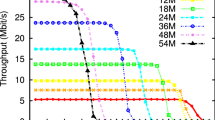Abstract
Many companies, organizations and communities are providing wireless hotspots that provide networking access using 802.11b wireless networks. Since wireless networks are more sensitive to variations in bandwidth and environmental interference than wired networks, most networks support a number of transmission rates that have different error and bandwidth properties. Access points can communicate with multiple clients running at different rates, but this leads to unfair bandwidth allocation. If an access point communicates with a mix of clients using both 1 Mb/s and 11 Mb/s transmission rates, the faster clients are effectively throttled to 1 Mb/s as well. This happens because the 802.11 MAC protocol approximate “station fairness”, with each station given an equal chance to access the media. We provide a solution to provide “rate proportional fairness”, where the 11 Mb/s stations receive more bandwidth than the 1 Mb/s stations. Unlike previous solutions to this problem, our mechanism is easy to implement, works with common operating systems and requires no change to the MAC protocol or the stations.
Similar content being viewed by others
References
A. Balachandran, G. Voelker, P. Bahl and P. Rangan, Characterizing user behavior and network performance in a public wireless LAN, in: Proceedings of ACM SIGMETRICS (2002).
D.-M. Chiu and R. Jain, Analysis of the increase and decrease algorithms for congestion avoidance in computer networks Comput. Netw. ISDN Syst 17(1) (1989) 1–14.
M. Heusse, F. Rousseau, G. Berger-Sabbatel and A. Duda, Performance anomaly of 802.11b, in: Proceedings of IEEE INFOCOM 2003, San Francisco, USA (2003).
HostAP, HostAP. http://hostap.epitest.fi/.
C. E. Koksal, H. Kassab and H. Balakrishnan, An analysis of short-term fairness in wireless media access protocols (poster), in: Measurement and Modeling of Computer Systems (SIGMETRICS) (2000) pp. 118–119.
D. Kotz and K. Essien, Analysis of a campus-wide wireless network. in: Proceedings of the Eighth Annual International Conference on Mobile Computing and Networking, ACM Press (2002) pp. 107–118.
J. McCann, S. Deering and J. Mogul, Path MTU discovery for IP version 6, IETF RFC, 1981 (1996).
J.C. Mogul and S.E. Deering, Path MTU discovery. IETF RFC, 1191 (1990).
S. Pilosof, R. Ramjee, D. Raz, Y. Shavitt and P. Sinha, Understanding TCP fairness over wireless LAN, in: Proceedings of IEEE INFOCOM 2003, San Francisco, USA (2003).
W.R. Stevens, TCP Illustrated: Vol. I (Addison-Wesley Publishing Co., 1994).
M. Wentink, T. Godfrey and J. Zyren, Overcoming 802.11 gs interoperability hurdles (2003). http://www.commsdesign.com/showArticle/?artidleID=16501220.
Author information
Authors and Affiliations
Corresponding author
Additional information
Joseph Dunn received an M.S. in computer science from the University of Colorado at Boulder in 2003, and B. S. in coputer science and mathematics from the University of Arizona in 2001. His research interests are in the general area of computer systems, primarily focusing on security and scalability in distributed systems. He is currently working on his Ph.D. in computer science from the University of Colorado at Boulder.
Michael Neufeld received a Ph.D. in Computer Science from the University of Colorado at Boulder in December of 2004, having previously received an M.S. in Computer Science from the University of Colorado at Boulder in 2000 and an A.B. in Computer Science from Princeton University in 1993. His research interests are in the general area of computer system, specifically concentrating on wireless networking, software defind/cognitive radio, and streerable antennas. He is currently a postdoc in the Computer Science department at the University of Calorado at Boulder pursuing research related to software defined radio and new MAC protocols for steerable phase array antennas.
Anmol Sheth is a Ph.D. student in Computer Science at the University of Colorado at Boulder. He received his B.S. in Computer Science from the University of Pune, India in 2001. He has been co-leading the development of the MANTIS operating system. He has co-authored three papers include MAC layer protocol design, energy-efficient wireless communication, and adapting communications to mobility.
Dirk Grunwald received his Ph.D. from the University of Illinois in 1989 and joined the University of Colorado the same year. His work addresses research and teaching in the broad area of “computer systems”, which includes computer architecture, operating systems, networks, and storage systems. His interests also include issues in pervasive computing, novel computing models, and enjoying the mountains. He is currently an Associate Professor in the Department of Computer Science and in Electrical and Computer Engineering and is also the Director of the Colorado Center for Information Storage.
John Bennett is a Professor of Computer Science with a joint appointment in Electrical and Computer Engineering at the University of Colorado at Boulder. He also serves as Associate Dean for Education in the College of Engineering and Applied Science. He joined the CU-Boulder faculty in 2000, after serving on the faculty of Rice University for 11 years. While at Rice, Bennett pioneered a course in engineering design for both engineering and non-engineering students that has been emulated at several universities and high schools. In addition to other teaching awards, Bennett received the Keck Foundation National Award for Engineering Teaching Excellence for his work on this course. Bennett received his Ph.D. in 1988 from the University of Washington. Prior to completing his doctoral studies, he was a U.S. Naval Officer for several years and founded and served as President of Pacific Mountain Research, Inc., where he supervised the design and development of a number of commercial computing systems. Bennett's primary research interests are broadly focused in the area of distributed systems, and more narrowly in distributed information management and distributed robotic macrosensors.
Rights and permissions
About this article
Cite this article
Dunn, J., Neufeld, M., Sheth, A. et al. A Practical Cross-Layer Mechanism For Fairness in 802.11 Networks. Mobile Netw Appl 11, 37–45 (2006). https://doi.org/10.1007/s11036-005-4459-z
Published:
Issue Date:
DOI: https://doi.org/10.1007/s11036-005-4459-z




